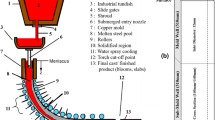Abstract
A three dimensional simulation of molten steel flow, heat transfer and solidification in mold and “secondary cooling zone” of Continuous Casting machine was performed with consideration of standard k−ε model. For this purpose, computational fluid dynamics software, FLUENT was utilized. From the simulation standpoint, the main distinction between this work and preceding ones is that, the phase change process (solidification) and flow (turbulent in mold section and laminar in secondary cooling zone) have been coupled and solved jointly instead of dividing it into “transient heat conduction” and “steady fluid flow” that can lead to more realistic simulation. Determining the appropriate boundary conditions in secondary cooling zone is very complicated because of various forms of heat transfer involved, including natural and forced convection and simultaneous radiation heat transfer. The main objective of this work is to have better understanding of heat transfer and solidification in the continuous casting process. Also, effects of casting speed on heat flux and shell thickness and role of radiation in total heat transfer is discussed.












Similar content being viewed by others
Abbreviations
- C1, C2, C3:
-
Constant
- c p :
-
Specific heat at constant pressure [J/(kg.K)]
- g :
-
Magnitude of gravity [m/s2]
- h :
-
Sensible enthalpy
- h ref :
-
Reference enthalpy
- h ext :
-
Convection coefficient
- H :
-
Enthalpy
- K :
-
Conductivity [W/(K.m)]
- L :
-
Latent heat of the material [J/kg]
- ΔH :
-
Latent heat [J/kg]
- Q w :
-
Water flow rate in spray zone [L/(m2.K)]
- S :
-
Sink Term
- T :
-
Temperature [K]
- T solidus :
-
Temperature [K]
- T liquidus :
-
Temperature [K]
- T ref :
-
Reference temperature [K]
- T surface :
-
Surface temperature [K]
- T ambient :
-
Ambient temperature [K]
- T spray :
-
Temperature of the spray cooling [C]
- h nat :
-
Natural convection heat-transfer coefficient [W/(m2.K)]
- h spray :
-
Spray cooling heat-transfer coefficient [W/(m2.K)]
- T ext :
-
Cooling water temperature [K]
- u :
-
Velocity component [m/s]
- \( \overrightarrow {\upsilon } \) :
-
Fluid velocity [m/s]
- \( \overrightarrow {{\upsilon_{p} }} \) :
-
Pull velocity [m/s]
- P :
-
Pressure field [N/m2]
- y + :
-
Non-dimensional cell size at the wall
- y :
-
Distance from the wall
- α:
-
Machine dependent calibration factor
- β:
-
Liquid fraction
- ρ:
-
Density [kg/m3]
- μo :
-
Laminar viscosity [kg/(m.s)]
- μ t :
-
Turbulence viscosity [kg/(m.s)]
- k :
-
Transport of turbulent kinetic energy [m2/s2]
- ε:
-
Dissipation rate of kinetic energy [m2/s3]
- ε R :
-
Surface Emissivity
- σ:
-
Stefan-Boltzmann coefficient [W/(m2.K4)]
- ϕ:
-
Turbulent parameter that is solved
- i, j:
-
Coordinate direction indices, which when repeated in a term, imply the summation of all three possible terms
References
Hagiwara M, Inoue A (1993) Production techniques of alloy wires by rapid solidification techniques. In: Liebermann HH (ed) Rapidly solidified alloys conf. Marcel Dekker, New York, pp 139–156
Boettinger WJ, Perepezko JH (1993) Fundamentals of solidification at high rates. In: Liebermann HH (ed) Rapidly solidified alloys. Marcel Dekker, New York, pp 17–78
Herlach DM, Willnecker R (1993) Under cooling and solidification. In: Liebermann HH (ed) Rapidly solidified alloys. Marcel Dekker, New York, pp 79–102
Thomas BG, O’Malley R (2000) Validation of fluid flow and solidification simulation of a continuous thin-slab caster. MCWASP IX Conf., Shaker Verlag, GmbH, Aachen, pp 769–776
Meng Y, Thomas BG (2003) Heat transfer and solidification model of continuous slab casting: CON1D. Metall Mater Trans B 34B(5):685–705
Voller VR (1987) Modeling solidification processes. Technical report, mathematical modeling of metals processing operations conference, American Metallurgical Society, Palm Desert, CA
Voller VR, Brent AD, Reid KJ (1987) A computational modeling framework or the analysis of metallurgical solidification process and phenomena. Technical report, conference for solidification processing, Ranmoor House, Sheffield, Sep 1987
Creech DT, Thomas BG (1998) 3-D turbulent multiphase modeling of molten steel flow and heat transfer in a continuous slab caster. CFX User’s conference, Wilmington, DE, 1 Oct 1998
Hardin RA, Liu K, Kapoor A, Beckermann C (2003) A transient simulation and dynamic spray cooling control model for continuous steel casting. Metall Mater Trans B 34B:297
Brimacombe JK, Agarwal PK, Hibbins S, Prabhaker B, Baptista LA (1984) Spray cooling in the continuous casting of steel. Contin Cast 2:109–123
Nozaki T, Matsuno JI, Murata K, Ooi H, Kodama M (1978) Thermal soft reduction incontinuously cast slabs. Trans Iron Steel Inst Jpn 18(6):330–338
Bolle L, Moureau JC (1979) International conference on heat and mass transfer in metallurgical processes. Dubrounik, Yugoslavia, pp 527–534
Nozaki T (1978) A secondary cooling pattern for preventing surface cracks of continuous casting slab. Trans ISIJ 18:330–338
Laitinen E, Neittaanmäki P (1988) Numerical solution of the problem connected with the control of the secondary cooling in the continuous casting process. Control-Theory Adv Technol 4:285–305
De Bellis CL, Le Beau SE (1989) ASME Nat. Heat Transfer Conf. Proc. HTD 113:105–111
Touloulian YS, Powell RW, Ho CY, Clemens PB (1972) Thermo physical properties of matter, vol 8. IFI/Plenum, New York
Acknowledgments
The authors would like to express their gratitude to the supporters of this work especially H. Ajam and S. Seyyedy.
Author information
Authors and Affiliations
Corresponding author
Rights and permissions
About this article
Cite this article
Sadat, M., Honarvar Gheysari, A. & Sadat, S. The effects of casting speed on steel continuous casting process. Heat Mass Transfer 47, 1601–1609 (2011). https://doi.org/10.1007/s00231-011-0822-8
Received:
Accepted:
Published:
Issue Date:
DOI: https://doi.org/10.1007/s00231-011-0822-8




